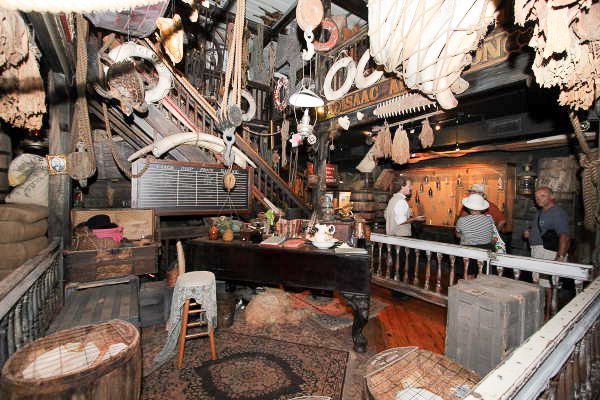
The premier attraction at Key West’s Shipwreck Museum is the salvaged cargo of the Isaac Allerton. The square-rigged merchant ship of 594 tons measured 137.2 feet in length, was built with two decks, and sold at auction on Jan. 19, 1839. Henry F. Jackson of Plymouth, Massachusetts, purchased the ship and christened it the Isaac Allerton.
The ship’s namesake had been a passenger on the Mayflower. Allerton later served as the assistant to Governor Bradford of the Plymouth Colony in 1621. The vessel named in his honor was generally used to conduct packet routes between New York and New Orleans, though it also made three voyages to Liverpool, England. William Nelson and Sons of New York later owned the Isaac Allerton. Roswell B. Baldwin was the ship’s master, and it was Captain Baldwin who was at the helm when the ship met its fate. (Fun fact: Hollywood’s Baldwin brothers are descendents of Roswell Baldwin.)
The Isaac Allerton sailed away from New York on Aug. 5, 1856, and carried a cargo of, among other items, ivory toothbrushes, Mexican Mustang Liniment, champagne, beer, silk, gloves, china, lockets, portable inkwells, a bronze bell for the First Presbyterian Church of Memphis and 14 carved pieces of white marble bound for the U.S. Customs House in New Orleans.
It was Aug. 27 when Capt. Baldwin began encountering contrary weather patterns, and shortly after that, hurricane forces began pushing the Isaac Allerton up and over the reef. The Category 3 hurricane stormed across the Florida Straits between Aug. 25 and Sept. 3, with wind speeds estimated at 100 mph. The storm sank the Isaac Allerton off of Washerwoman Shoal, about 15 miles east, southeast of Key West, with a cargo valued at $350,000 or $400,000, depending on the source. In today’s market, $400,000 in 1856 would equal a little over $14 million.
In the wake of the storm, Capt. George Aldersdale, of Key West, was the first wrecker on the scene. Being the first to arrive positioned him as the wreck master. The wreck master was determined by both effort and fate and went to the first licensed wrecking captain who arrived on the scene and presented his wrecking license to the master of the imperiled ship. It was the wreck master who decided precisely how the operation would go down and how many crews were needed; the wreck master also received the largest cut of the salvage award. The massive salvage operation of the Isaac Allerton involved 433 wreckers.
Because the ship sank in five fathoms, or 30 feet, of water, much of the work was done by about 20 divers. Additional cargo was salvaged by “fishing” for it with iron hooks or pegs attached to long staves or wooden planks. The schooner Florida rescued survivors and brought them to Key West.
The initial salvage operation occurred over a period of six weeks and netted a total value of about $96,000 worth of cargo, or about one-quarter of the value of what went down with the ship. After costs associated with general expenses, wharfage, storage and other charges were deducted from the gross value of the salvaged cargo, a claim of $43,852 was awarded to the wreckers.
Jefferson B. Browne, in his 1912 book “Key West: The Old and the New,” wrote, “In the case of the Isaac Allerton the largest individual awards were made, which was due to the fact that most of the cargo — an extremely valuable one — had to be dived for and many of the divers’ eyes were seriously injured by the water which was impregnated with dyes from dry goods and the many other articles which composed the cargo.”
One diver received a $769 share of the salvage award; five others received shares of $500 each. The rest of the crews were given between $100 and $1, with the average share being $50, or about $1,784 in 2023 terms.
Two or three months after the initial salvage operation, a schooner with six or eight men from Boston sailed up on the wreck site with submarine armor and worked the wreck for a reported four to five weeks — whenever the weather cooperated. They were able to salvage an additional $1,027 worth of cargo.
Over 130 years later, in 1985, Steve and Ray Maloney rediscovered the wreck of the Isaac Allerton. The Maloney family has an extensive history in the Florida Keys that dates back to Steve and Ray’s great-great-great-grandfather Walter C. Maloney. In the 1830s, Maloney lived on Indian Key and worked for the legendary Jacob Housman, the wrecker king of Indian Key.
In his Indian Key days, Maloney served as Housman’s bookkeeper. Fortunately for Maloney and his family, they relocated to Key West just days before the Indians attacked the island on Nov. 7, 1840, during the second escalation of the Seminole War. After moving to Key West, Maloney studied law and passed the Florida bar in 1855. The following year, he represented the interests of Isaac Allerton when the salvage claim was adjudicated in court.
For nearly three decades, cargo salvaged from the wreck by the Maloney brothers has been on exhibit at the Key West Shipwreck Museum. The fees paid to the Maloneys for exhibiting the items have helped them continue to work the wreck. The Maloney claim to the Isaac Allerton is an active working salvage operation. Only a small percentage of the ship’s cargo has been salvaged.
























